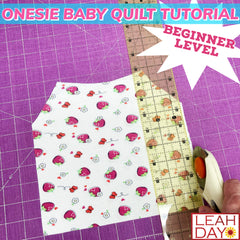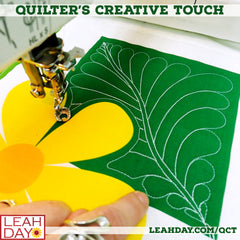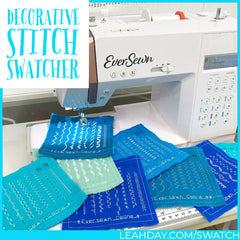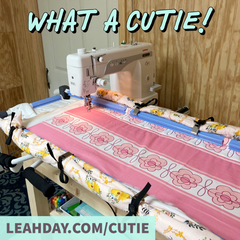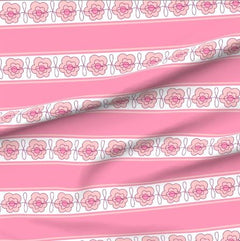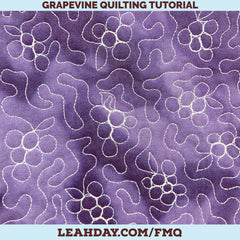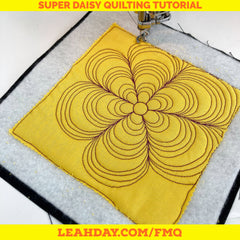Let's talk about fabric design with Sandra Clemons. Now, Sandra is a quilter. She's an author. She is a self-publisher and she's a fabric designer and her new line of fabric is called Front Yard. It was developed by Michael Miller Fabrics.
Today, we're going to talk about fabric design and Sandra's process and a little bit about how she created her booth at quilt market. I really enjoyed hearing Sandra's experience and her design process just learning more about the behind-the-scenes of fabric design.
I've done a little bit of this but hearing from Sandra really brought home like when you're serious about something and you're dedicated to it, it's like you bring a whole different side of yourself to the table and Sandra's definitely bringing it when it comes to fabric designs. I think you're going to find this really interesting.
Sandra's website is sandramakeitblossom.com.
The Tunic Challenge
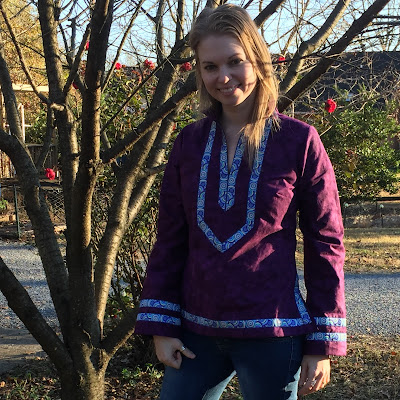 The tunic challenge is the other thing that I was working on. We have finished that. That was a little collaboration project with Amy Johnson and Amy and I both posted our final pictures on Saturday.
The tunic challenge is the other thing that I was working on. We have finished that. That was a little collaboration project with Amy Johnson and Amy and I both posted our final pictures on Saturday.
Find Amy's last tunic post here - freemotionquiltingadventures.com and then find my last tunic challenge post here - freemotionproject.com.
We both finished tunics that, I would say, are not exactly perfect like I made some mistakes with my color and I put so much ribbon trim on mine that it's very dressy. It's a lot more formal than what I was expecting. I'm so, so happy that I made it because now that I understand and can use the pattern, I can use it to make so many different things.
I think the next thing I want to make, I want to make a sweater tunic. They have a v-neck sweater style plaquette within the pattern and I want to get some sweater fabric. That's what I'm going to be looking for in fabric stores in the next couple of weeks. I'm going to look for like a really nice chunky knit and make a real chunky tunic and that will be fun.
I really enjoyed the tunic challenge. It was so nice to have that push, to make something for myself and I know I wouldn't have done it without Amy's help. I had a deadline essentially and this is something that I'm really working on especially in this coming year is how do I set deadlines for myself when it's just me by myself, when there's no one else involve.
That's really tricky for me. I really struggle with this because I easily set deadlines and make things happen for other people but I really don't prioritize well when it's just something that I'm making for me just for fun.
I want to work on that and read some more about it. I'm going to look up some books on time management and productivity and just be researching that a little bit. How I research things is I find an audio book on it and then I listen to it while I quilt and that's my form of research and learning something new and that really works for me.
Fabric Design Interview with Sandra Clemons
Hello, my quilting friends. Leah Day here with Sandra Clemons from https://sandraclemons.com/
Sandra Clemons: Hi, so glad to be here.
Leah Day: Excellent. Today, we're going to talk all about fabric design and you want to get started just talking about how you got into this and how you became a fabric designer?
Sandra Clemons: My story perhaps is not as similar as other designers. I started off as a dedicated quilter. I was quilting for about 12 years or so and from that point, I wanted to get into the business and so I started with writing patterns and I authored a book and I started getting published in magazines. I wanted to make my business more profitable. I wanted to turn my business into something that was more of a viable business that I could have and the next step for me was learning fabric design.
From there, I just started to relearn how to draw and how to use Illustrator. I picked up some textbooks to learn how to repeat patterns and the such. I spent perhaps maybe six to eight months working on that, pulling collections together, picking up color schemes, that type of thing and then I went to market it. I pitched it out to as many manufactures that would spend time with me and I walked away with the deal with Michael Miller. That's really how my background started with fabric design.
Leah Day: Excellent. You've just in the one line of fabric so far with Michael Miller?
Sandra Clemons: Yes. It's called Front Yard. Yeah, it's my first one so I'm very, very excited about it and yeah, I'm already working on my second one as it is and I already got on my strike-offs in from that process. It's interesting. You're promoting your current line while you're already working on your next one. Yeah, I feel very green in this process but I'm learning and I'm learning quickly. I feel like I have a certain edge, if you will, perhaps than other designers because I do come from ... I feel like I'm a quilter. I feel like I'm someone who got into quilting because I loved it and that's how I grew from there.
Leah Day: Excellent. You mentioned the word strike-offs and some people might not even know what that means. Can you take us step by step through the process like from sketching to Illustrator to working with the company, the whole nine yards? I'm sure everybody like to know more about it.
Sandra Clemons: Okay. Let me try my best. This is only my second round. I started off with just brainstorming a story, something that I want to pull a collection around. A lot of times, that inspiration comes from these small moments that I have with my daughter, whether we're outside or we're at our family farm or whatnot. All of a sudden I have a theme for my collection.
From there, I take a lot of photography so that's some of my background. I'll start with photography and I'll start with some sketching. I really like the hand-drawn look that's on fabric but there are some things that I want to portray and illustrate but I don't feel like I have quite the drawing skills to master. I cheat in a way by taking a picture of it and then I bring it in to my computer and then I traced it.
That's usually how I cheat around some of those things. From there, right now what I'm doing with color, I take a lot of pictures of flowers or things outside. From there, that will start getting me thinking about what kind of color scheme that I want to use. I also go out into ... I'm really into fashion. I like to see what color trends are coming up and I like to pay attention to see what Pantone's next color of the year is and see if that perhaps inspires me for color.
From there, I used the Michael Miller Cotton Couture solids and so I'll pull out perhaps 16 to 20 different colors out of there that I would want to work with. From that, I'll match that in Illustrator and I just play around with it, making sure that I have the contrast that I want and I have a nice spectrum of color there.
Then, from my drawings and then my photographs, I just bring them into Illustrator. I mostly work in Illustrator and that's where I'll color the art or repeat the art and that type of the thing. The first go with Michael Miller, I had a huge binder and I probably had, I don't know, 250 designs in there. I just had a ton. I was just really seeking to be a fabric designer so I just put like a bunch of stuff in there. They picked through that and that's what came for my first collection.
Now, with my second collection, I came up with maybe, I think, with like 15 designs that I send off to the art department and they rework with those to bring it down to about eight or nine different art pieces that we're going to color. Then, we'll work together and at the same time, I'll pitch what colors I want to use and then we'll work together and collaborate on the knowledge that they have about color and pulling collections together and then also my vision of how I want to see my collection because I come from a vision of seeing it pull together in a quilt.
Then from there, we'll agree on the colors and we'll agree on the number of designs we're going with and then they send that over to get strike-offs. Strike-offs, it's like the best part of the process because that's when you finally see your art printed on fabric. This is just like a draft. You get like a small little swatch that you look at and you review that just to make sure that you're happy with color and the way that it printed and that type of stuff so then you collaborate again. With me, I collaborate with Michael Miller and give feedback and then if there's not a lot of comments, then they'll go to printing. That's really, really exciting.
That's pretty much my process. I don't know if I was thorough enough but that's what I know for right now going in my second collection. I hope that's helpful for people.
Leah Day: Yeah. I'm thinking about bringing 250 designs and like cha-chunk! here you go, fix something out of that. That's awesome. I think that's such a good way to like go into it with so much created. I heard this once from Mr. Rogers. He created 10 songs and he went and pitched them and he got turned down and someone gave them the advice, they were like, "No, create a hundred songs and then come back." By the time he created a hundred songs, he was already working for himself. He was like, "I don't need anybody else to approve of me." I love that. That's such a cool thing. Incidentally, did you like the Pantone colors of the year this year, the baby pink and baby blue?
Sandra Clemons: I really didn't mind them. I have a five-year-old so I felt like I'm used to seeing those colors within like a baby scheme but really when they first came out, I didn't mind them because I do work with pastels if you will and I like working with contrast. When I first saw them, I already thought about how to pair them up with darks. I don't know. I like to evolve. I like to get pushed outside of my box. It wasn't really ... I wasn't upset about it. I was like, "All right."
Leah Day: I just remember there was almost like warfare across several quilting blogs. They were like everyone was angry for that first couple of weeks that it came out. I kept seeing these posts like ranting about it. I don't really use the Pantone colors of the year but I just found that really interesting last year that it was such a big deal.
Sandra Clemons: Yeah.
Leah Day: Getting back to fabric design, you said that your inspiration comes from your daughter and then things that you photographed, this new line that you're working on, what was the inspiration for it if you can share that? I don't know how much you can share about your new line that's not even come out yet.
Sandra Clemons: Well, I would say nearly every Fourth of July, we go to my husband's family farm for the weekend. It's just farm and stuff, West Missouri and it's just slow pace. I live in Denver and everything is just the hustle and bustle and just getting your kid one place to another. To go to the farm, it's just a different experience.
For me having a daughter there perhaps just a slower pace of it has me appreciating the environment more, meaning that I'm very much a busybody. I always like to be doing something. I always like to be multitasking. A lot of the times, that's okay but sometimes, I really need to just stop and just relax and just treasure the moment.
Anyhow, this last Fourth of July, I was just noticing like all the things that my daughter was interested in like she found a frog in the pool and then there's these butterflies fluttering around and there are rose garden and then there was like these giant and then like all the wild flowers that are out there and just noticing like what she's picking, like she was just into these clovers and I don't know.
Anyhow, it's just seeing what she gravitated towards. Then that's what ... Because I take a lot of pictures of her and so now, it's transferred to what is she interested in as I'm capturing these photos. It's going to be just a lot of things about life on the farm in southwest Missouri.
Leah Day: That sounds so relaxing. It sounds wonderful. I very much know exactly what you're talking about. My husband and I have been talking about getting like a little cabin in the woods so we could have a place to just go and relax and have no internet so we cannot work, you know what I mean? That would be nice.
Sandra Clemons: Yeah. They do not have any internet. They do not have any cable. It's not that I'm much of a TV person but it is the weekend of Wimbledon. I'm a big tennis fan. Anyhow, it's just been nice to just get off the phone, get off the social media, get off ... You know what I mean? Just to spend time with one another, talk to one another.
Leah Day: Yeah. Media fast. I totally get that. Whenever you're first initially drawing and you're getting those colors out, so you work with like the solid fabric swatches and that's what helps you get the color just exactly. When you get your swatches, your strike-offs from Michael Miller, it's then just the process of making sure that everything lines up, right?
Sandra Clemons: Well, sometimes I'm looking if two colors are next to each other. There's a term that they use and I can hear one of those ladies who has been so helpful over there in my head right now but I can't come up with a word. Sometimes, when two colors that don't have a lot of contrast are next to each other, it can create like this halo around the object of the art.
A lot of times, you want to avoid that and so perhaps, you may decide to change one of the colors. You might want to go a little lighter or go a little darker so that it doesn't have that halo. There's other things. There's a lot of times at the beginning, you're just working with printing, like you're printing these designs so to see them finally on fabric, perhaps the colors came out maybe just a little too dark than you expect or a little too light and that type of thing.
At that point, they've already etched the design for printing so you can't really go back and change anything in the art piece. If you're like, "Whoa, whoa, whoa, now that I see it, maybe I don't like how that leaf overlaps that flower." They're going to be like, "Umm, you're just going to have to live with it because we already paid money to get those plates printed for you."
I believe they can change the repeat pattern, if you will, but when you're talking about the specific plate, once they sent it off for fabric printing for those strike-offs, you're done. It's very fun and I enjoyed it. There is still a lot for me to learn and the folks at Michael Miller just are very patient with me as I'm learning the process and the ins and out of fabric printing. It's very exciting.
Leah Day: That's wonderful. I know that they're so helpful. I'm sure that other people that are interested in this, they would probably be more likely to want to go and pitch Michael Miller. It certainly just makes me feel good that they're there every step of the way to help you.
Tell me as far as the process, about how long does it take? If you were drawing something around Fourth of July and you submitted your designs, the back and forth. About how long does it take to even see the fabric in like bulk form, ready to sell on the shelf?
Sandra Clemons: It's a difficult question, meaning I think every designer has a different time period in terms of how they're going to a design the fabric collection. From Michael Miller's point of view, they have a deadline for me to submit at that point. I have to plan ahead of that.
If I want to take six months, I just have to anticipate that I have this deadline coming through. They do send like a month reminder out so like a month before. Perhaps there are some designers who can just knock one out in a week, I'm not sure. I'm clearly not at that level but I do take a lot of time. For example, my second collection, I have been thinking and pondering and I have been practicing my sketches in my sketchbook. I have been pondering it for quite sometime and it was due, I want to say just a few weeks before quilt market.
I guess I'm brainstorming drawing and it will probably take about six months to pull all my thoughts together. When I into Illustrator, at that point, I already know what colors I want to work with. It'll probably take me like a month there but I'm not rushing that at this point. I just want to enjoy taking the time so that I can get something out there that I really love and that makes a lot of sense not only for me but also for quilting.
That's been one of my things is that with a lot of fabric collections, you may not see a whole lot of contrast within the main colors that they picked within the collection and I really want to see some contrast because I like contrast in my quilts and so that's something that I really want to focus on, is making sure that I have that level of contrast in my collection.
Anyhow, once it goes to Michael Miller, I think it's probably like six weeks or so ... Let's say, I sent this last one out a few weeks before quilt market, they review it and we dialogue. Then right before quilt market, so probably two weeks, I knew what designs we were going with and I knew what colors we were going with.
I just got my strike-offs for the second collection Monday this week. Here we are end of November, so probably six weeks to see strike-offs and now, we're going to go through review process for that. I know sample yardages come in, I believe, February. It's a sample yardages. It's when they send you a yard of each of your design so that you can start with working on your samples. For me, I'm working on these samples for quilt market.
It does vary for spring market and fall market but I don't know. Is that helpful?
Leah Day: Yeah.
Sandra Clemons: I'm not very clear, is it?
Leah Day: No, absolutely. It's very, very helpful especially understanding the work behind it because it does sound like a lot of work and then not just designing the fabric, then you've got to go to market too and put together a booth. Do you want to talk about that?
Sandra Clemons: Yeah. I did my first booth in ... I did hard walls. I do know a little bit about woodworking. My dad would be so proud of me. Yeah, I built 10 panels that I basically pieced together for a 10 by 10 booth space and I took a corner space. I paid for a corner space rather than the inside because I had less walls to deal with.
I started working on that in the summer just anticipating that I knew I wanted to give my hard walls done before my sample yardages came in. Yeah, I just built that out in my garage. I have some photos of the building process on my Instagram feeds so you have to search for those out there. Then, yeah, that was quite an experience.
We had to make sure that they measured in size so that it could fit into a vehicle. My husband and I rented a Yukon, huge monster of car. We loaded that thing up with these walls and everything I needed for the booth and then we drove 16 hours to Houston to set it up. It was quite an experience for us. There was a lot of memories tied to it because that was the first time my husband and I had spent eight days together without a child. We had done like a night or two but this was eight days without a child. It was nice. It was nice for him to see many people within the industry and understand more in detail what I'm trying to do.
The booth, man, there is quite a few trips to IKEA and sizing and making sure it can fit in the car. I'm saving it for the next market for St. Louis but I was thinking about pitching it after that, I don't know. It's quite a beast to haul around but it looks nice. Like hard walls look a lot nicer.
Some people choose to do curtains or they chose to run out off to like Home Depot and do core board or felt board, insulation boards and then they just pitch it at the end, I don't know. I just felt like I had to do hard walls and we'll see how well I'll haul that thing, keep that thing tied to me. I think St. Louis will be the last one and I'll have to figure out another process.
Leah Day: You built the hard walls and you decorated your booth and you had to pay for your booth too. All of these are expenses that are coming with the fabric launch, did you have to do all of these things or were these things that you wanted to do?
Sandra Clemons: For the first collection, I did want to do it. Let me back up, Michael Miller does pay half of the expense for the booth, so that's nice. I know not every fabric manufacturer does this, so they do pay half. I did want to go big. I wanted to make a presence at market and I just thought that perhaps the extra level at detail, perhaps would just have me stand out a little bit more perhaps.

Michael Miller pays for half of that costs but in terms of building it, putting it all together, the time, that was all on me. Do I sense some pressure perhaps from Michael Miller to do a booth?
The lady I worked with before, she didn't really push me one way or another though if I wasn't going to do a booth, they weren't going to have space in their booth for me to showcase my collection. You see what I'm saying? If you wanted your collection shown like on a wall with samples, you have to get a booth.
With this going on, I really wanted to do it. Had I said no, I'm not sure how that conversation would have went, so I don't know.
Leah Day: With all those expenses and I've done a booth. Josh and I did our first booth several years ago at Spring Quilt Market so I know it is a big deal and it's a big chunk and change to put out and then there's a lot riding on it. You wanted to be successful and you wanted to do well. Has this been successful as far as like the fabric line and paying for that and so the expenses balanced out? Or do you not know yet? Because the fabric hasn't launched yet, right?
Sandra Clemons: Right. They're pre-selling and should be out in January. There was a lot riding on it and to be completely honest, that last week getting ready, there was just a lot of anxiety and pressure. There's this time away that ... Weekends that I'm spending on my business and not spending time with my family, it's grabbing extra time for my husband to help me paint the walls in the booth when we would rather be doing something totally different.
Yeah, that last week before market, I had a lot of anxiety and some of my friends within the industry were very patient with me, just to ... How do you anticipate sales? How do you process sales? Because on top of the booth, I wanted to sell my own patterns as well and I wanted to pre-sell my second book called Simple Patchwork. It's like, how do you plan for that? How much inventory do you bring? What are these shop owners expecting in terms of how prepared you are to be there, because you're trying to make up your cost for the booth, the cost of getting down there, the cost of staying there and just building out the booth.
For me, I really wanted to reach break-even and the verdict is still out for that. It's my first one and you got to start somewhere, right? Hopefully, it's a different conversation when I'm in my second collection, a different conversation when I move to my third collection and so forth.
Leah Day: It sounds like definitely a building process so that each collection builds on itself. From what I understand, collections can come in and then they're almost like books. They can go out of print. Do you know how long your collections will stay in print?
Sandra Clemons: As long as they have inventory for it from what I understand. That's an interesting question because not every fabric manufacturer perhaps works that way I like, I chose Michael Miller because they do have a longer shelf life in terms of the collections that they have. There are other manufacturers where there's a very strict schedule that happens throughout the whole entire year and perhaps your collection may only live for about three months before they move on to the next thing or whatnot.
Michael Miller does have a longer shelf life. I'm still learning about what that shelf life looks like because it does dictate based of sales, like if you sell out right away, perhaps the next step would be for a business is to order another round of that but if your first collection is taking a while to sell, the longer it perhaps lives out there because, of course, I'm interested and as well as Michael Miller is interested in getting those sold and moved on off to shop owners and that type of thing.
That's something I'm still learning and navigating with my first collection. I'm right at that step where we're pre-selling and then January, they'll start getting shipped out to stores and we'll see what the feedback is. I know my feedback at market was really positive in terms of the people that I met there but I haven't seen my numbers in terms of pre-sales at market.
Market is not much of an indicator for sales like they have been in the past because so many shop owners now can see collections online so there's not a lot of incentive for them to want to take the cost, to incur the cost to go out to market. Perhaps a few years ago, market was a good indication of how well your collection will sell, say during that season but right now, it's hard to predict that right now. I am really curious about what my numbers are and I did follow up last week and they're still collecting their data together. Soon I should see what that looks like.
Leah Day: Yeah, it's such a cute one, the fabric. We'll make sure to include some pictures, if you can share some pictures with us. We'll put it in the show notes so people can come and see it. I've got the quilt block that I've shared in a video yesterday and so if anyone wants to see the quilt block that you sent me in, they can check out the Free Motion Quilting Project blog and see that. I know that that was a really fun collaboration project and I just loved that fabric that was included. They were really cute. You mentioned writing a book so you want to tell us about that? Is this your second book?
Sandra Clemons: Yeah, so I have a second book that I'm self-publishing called Simple Patchwork and the book is nine blocks done at three different sizes on a large scale. It comes in 12-inch, 24-inch and a 20-inch size block. Right now, I'm just seeing a lot of trends out there for sampler quilt but when you look at these sampler quilts, you're either having to make 100 blocks at 6 inches.
The idea behind this book is about getting that sampler look without investing the time. I believe it is a quilt that you can get done over a weekend, at least get the top done over in a weekend and you can get that sampler look without the time investment. It does come with 12 different layouts in there as well and as well as more information for a quilter to design their own type of study as well.

Yeah, it was an interesting process but I like having the control over book publishing. That's another venture that I got into this year and I'm still learning about that and yeah, very, very excited about it.It's my second book. I'm really excited about it. I'm supposed to be receiving the copies here in a few weeks. I can't wait to start shipping them out to the pre-sale orders.
Leah Day: Our very first episode of this podcast was about self-publishing versus traditional publishing. Was your first book traditionally published or self-published too?
Sandra Clemons: It was traditionally published. It was published through C&T Publishing. The people there, it was great. It's just that it was surprising how much work the author really has to put into it as well as the promotional side of it. I just got to a point where if I really want to grow my business, if I really want to make a viable income for my family, I'm going to have to take that risk, self-publish and go that route. That was truly what I wanted to do.
I think for folks to perhaps, for me, like I already knew a little bit about page layout. I can do photography, that type of stuff. That wasn't scary for me to just pull that together but I think for some that might be. Also you're paying into ... Well, I shouldn't say paying into but you're still engaging. When you engage with a major publisher like that, you are open to their distribution chain which perhaps can help your sales. Whereas when you're self-publishing, that's something you have to generate on your own.
That's something I'm working on right now, building those relationships, getting in front of people, getting book reviews, that type of the thing. Really, I felt like a lot of that stuff I was already doing from my first book. Yeah, we'll see. We'll see where it goes.
Leah Day: Just share the titles of your book, your first and second book.
Sandra Clemons: My first book is called Scrap Patchwork and my second book is called Simple Patchwork.
Leah Day:Cool and I love the idea of massive blocks. You said it's 12, 20 and 24?
Sandra Clemons: Yes.
Leah Day: That's huge, that's wonderful. Whenever I see these tiny itsy-bitsy little blocks, I'm like you can't quilt that. You know what I mean? Something big, you can actually manage to get in there and put some quilting designs and stuff and have some fun with it. Awesome. Writing your books, did you include your fabrics within your book, your most recent book?
Sandra Clemons: Yes, my most recent book does showcase my Front Yard fabric collection throughout so that was really exciting. Also, with these larger blocks, it also showcased the pretty fabric design as well so then they didn't get chopped up so small. When you're looking at these larger blocks, you might have like a 4 or 6-inch square. It does a really nice job of showcasing that fabric design on there. That was really exciting to play with and play with the design in terms of quilting, quilting [on it too 00:49:03]. It was fun. Yeah, I enjoyed it.
Leah Day: Yeah and I love that. To me, that is a perfect way of cross-promoting two things so that you have the fabric line and that's one way you're making money and then you've got the book and that's another way of making money. When someone sees the book and they like that fabric, they're going to want to buy the fabric to make their quilt from the book. It all makes sense to me.
Sandra Clemons: Yeah.
Leah Day: I think that's a really nice synergistic way of bringing those things together. You also have some sewing patterns that I saw on your site. They're really cute like a little kid sewing patterns for like dresses and stuff. You want to talk about that process of designing those patterns too?
Sandra Clemons: Yeah. My mom is a seamstress and so that's how I actually got into sewing, when I was younger. I was watching her make us clothes and Halloween costumes and dance and that type of thing. Just adding on to what you were saying, Leah, in terms of this business, I feel like it's very important to just look at things cross-functionally in terms of how you can cross-promote yourself. That was the deal with the book and the quilt patterns. The quilt patterns is what led me into fabric design because that was another way. Now that I'm in fabric design, there's a huge just growing popularity with garment sewing and so that was something that I knew about.
I wanted to give just some basics out there, something that was quick and easy. The audience, the focus of this was having these patterns in the quilt shops so perhaps a quilter who, let's say, a beginner or a garment sewer, so something kind of quick and easy. Yeah, I just designed a few staples out there. I knew like I wanted a basic tank and I wanted it with a razor back opening in the back. From there, I just drafted it on my side and you sew some samples out and so I just got some cheap fabric over at Jo-Ann's because these are just things like you're just working with. I'm working with muslin.
You work off fit and you put your measurements together that you pull ... I pulled it into Illustrator and then I manually graded each one of those. I didn't use a fancy system in terms of creating. I just wanted to make sure my curves looked good. I wanted to make sure my darts were exactly in the right spots for the different sizes, et cetera, et cetera.
Then, I had some folks test those out for me and pulled it all together into a pretty little package. What's different about my garment patterns is that I do use photography to illustrate the steps. Rather than trying to figure out what someone's drawing means in terms of how to finish a neckline, I'm actually showing live photos of what that would look like. I hope that's really helpful for people to see what they need to do to construct the garment.
Right now, yes, I do have a few lady patterns out there. I have a blouse and a cute little dress. I have a little girl's dress I called Tulip with tulip sleeves. I really love, love tulip sleeves so I had to do that for her. I have this fun, fun cape for girls. I think you can do it for boys perhaps. It's just that I used my Front Yard fabric in it and I bound it with pink and it's really cute and it's a paper piece little triangle that trims the edges so it makes it really fun for kids to play in.
I'm hoping that that's something that people like. If people really like that side of me in terms of design, that's something that I would really like to spend more time in and build another collection of patterns as well. Yeah, I'm just seeing what this first season is going to look like and I classify my seasons in terms of each fabric collection. When Front Yard starts shipping out in January, I'll be able to just see what all these pieces ... I like to use data to tell me what people like and if that's something that people like, I would love to do some more in that arena.
Leah Day: Excellent. It sounds like you got a lot of different things going on but it's all coming together and flowing around the fabric and that seems to really work for you. You feel the same way like you aren't feeling completely overwhelmed by 50 million balls in the air, right?
Sandra Clemons: Well, this first year I did. I had to learn how to self-publish so that was a whole new process like, "Who am I going to print with? What are [inaudible 00:54:45]," that type of thing. That was a whole new process. Then, I was learning how to be a fabric designer. How do I collaborate and work with Michael Miller? What's Michael Miller expecting out of me? That was a whole other learning curve.
Then with the garments, for me, it was like how am I going to print on wide format? Like is that something ... Do I want to take the risk of getting 2,000 copies of it so I can print overseas or do I want to print in United States and manage my inventory at a much lower level or say on demand but pay three times the costs. You're learning about pricing. How am I going to price my book and garment pattern and all of these things are decisions that had to be made as well as building a booth, getting ready for quilt market.
Things have calmed down like after the first market, it was like a breath of fresh air like my booth's done. I've already self-published a book like I've learned all of these things in my first year and now, I can use all that information, continue to grow and it won't feel like I'm starting from scratch. Yeah, it did feel like I held a lot of balls up in the air but the outlook is good. I'm learning and I'm growing and I feel like I can only get better, better as a business woman, better as a designer, better as a publisher so I'm just looking forward to continuing to grow.
Leah Day: That is so awesome. Well, this has been so much fun. Why don't we finish up and you tell everybody where they can find you online and where they can find your fabric.
Sandra Clemons: Yeah, so you can find my fabric over at https://www.michaelmillerfabrics.com/ You can find it out there. There's a drop-down menu that has my name or you can just search for my name or Front Yard, you'll find it. It will be very easy. My website is also https://sandraclemons.com/
There, there's links out to my blog, different patterns. To all my social media outlets right now, I'm just Facebook, Pinterest and Instagram. You can definitely link and find me that way. If you're definitely out there in social media, I would love some just social media love so just go out there and follow me or like me or pin me, that would mean a lot to me as I continue to grow and make it blossom.
Leah Day: Excellent and this is the last question I always ask everybody, what is the thing that you are looking forward to most in the next five years?
Sandra Clemons: Well, like business-related or like personally?
Leah Day: Life, business, the whole nine yards, anything.
Sandra Clemons: Well, with all this design and this work that I've been doing, it's kind of thrown up all over the house and because of that, my daughter has been really inspired and she's been creating her own art based off of what I just like scraps and things that are out. I'm just really excited to see that as I'm growing in the next five years, how is she going to grow as well like what awesome idea or thing is she going to come up with that none of us are thinking about today. I'm just excited to see both of us grow in creativity. Yeah, so anyhow.
Leah Day: Excellent. Well, thank you so much for being here, Sandra. I had such a good time talking with you today.
Sandra Clemons: Yes, yes, it was fun. Thank you.
Leah Day: Thank you. Thank you so much for listening.
Until next time, let's go quilt!
Looking for more podcast episodes? Click Here to find them all!



